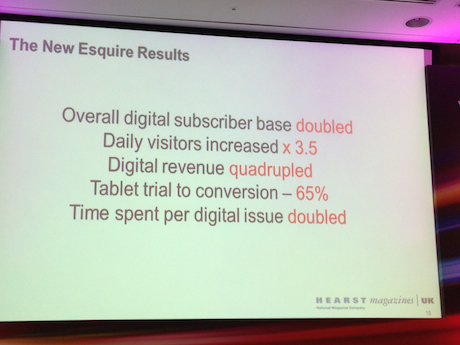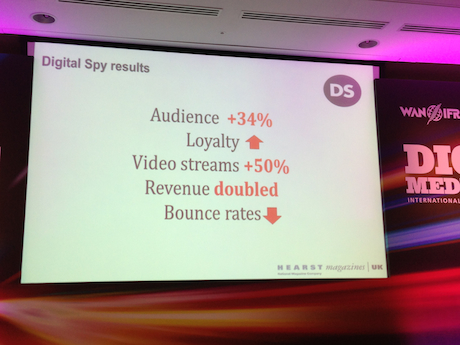
Hearst Magazine's digital strategy director, Rebecca Miskin, detailed how the publisher had adapted to the digital age at the Digital Media Europe conference in London yesterday.
"Building for the customer" by taking the product to where the reader is, recruiting "passionate and curious" digital staff and creating a "culture of innovation" were key, she said.
Miskin advised that publishers "create a culture of favouring simplicity and minimising complexity," adding that it was also important to "listen, measure and iterate" after launching a new product.
Miskin detailed three cases of when Hearst had successfully innovated.
Esquire
Before launching a digital product, the team at Esquire worked with specialists to find out "who the digital Esquire reader is", said Miskin.
"We got a picture of reader and then had to reimagine what that meant beyond the magazine," she said of the process, as editors and journalists took to the streets to find out more about their audience.
From there, the team "built a network of interactions under the Esquire brand" to better understand the "Esquire moments that we wanted to own".
Hearst launched a weekly, paid-for iPad app along with a bi-annual "Black Book" of fashion styles that was so popular the publisher took it to print alongside digital.
The changes increased engagement, traffic, subscriptions and revenue, Miskin said.

Digital Spy
Digital Spy, a site for digital media and entertainment, was a different beast from Esquire in that the editorial team "lived the brand", Miskin said, and were "segments of the audience".
Hearst launched a review into what should happen on mobile devices and developed new ideas by launching hackathons, designing a new logo and other digital assets over the course of five weeks as the team "lived and breathed the change", she said.
"The first week was a disaster as we thought we hadn't quite listened well enough," she said, as the audience took time to react to the changes.
Eventually though, traffic began to rise, but only after the organisation had "listened from the top" to what needed to change, as "being able to correct course was essential," she said.

Runner's World
The final example involved creating a separate product to supplement the magazine Runner's World.
In this case, "we knew what we wanted to build and had communities who knew exactly what they wanted," said Miskin. "It was people who know and love the magazine brand and were taking it to new places."
Rather than an app with the editorial focus that other Hearst magazines carried to their mobile products, the Runner's World app took a more practical approach.
'RunHub', as it was titled, included customisable training plans, route mapping, challenges, progress pages and community features to build a social element into the app, so like-minded individuals could enjoy their hobby together.
The process of innovating and creating new digital products at Hearst involved looking outside the publishing industry, said Miskin, into the world of "gaming, telephones and television" to find the talent and skills they were missing.
"We already had strong skills in magazines," she said, "but that wasn't what we needed to learn."
Looking ahead, Miskin stressed that publishers should look to embrace new technology at the same time as other industries and ask questions of how it may affect their work at an early stage.
"Tomorrow's technology is already here," she said. "This is the hybrid age where technology nudges our behaviour.
"It's all here but it's not happening in our industry yet. How will this change our content packages and the way audiences behave? How can our brands help our audiences in this rapidly changing environment?"
Free daily newsletter
If you like our news and feature articles, you can sign up to receive our free daily (Mon-Fri) email newsletter (mobile friendly).
Related articles
- ‘Question your assumptions’: Tips from Quartz on preparing for what comes next in digital
- Don’t just shut the door: What publishers can do to combat ad-blocking
- Is curation the way forward? A Swiss media group's take on getting people to pay for regional news
- How Spain’s El País is responding to digital transformation
- 5 ways news brands can take advantage of Linkedin









